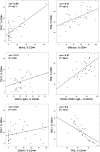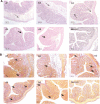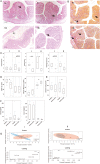The Combination of Patient Profiling and Preclinical Studies in a Mouse Model Based on NOD/Scid IL2Rγ null Mice Reconstituted With Peripheral Blood Mononuclear Cells From Patients With Ulcerative Colitis May Lead to Stratification of Patients for Treatment With Adalimumab
- PMID: 31782956
- PMCID: PMC7054775
- DOI: 10.1093/ibd/izz284
The Combination of Patient Profiling and Preclinical Studies in a Mouse Model Based on NOD/Scid IL2Rγ null Mice Reconstituted With Peripheral Blood Mononuclear Cells From Patients With Ulcerative Colitis May Lead to Stratification of Patients for Treatment With Adalimumab
Abstract
Background: To date, responsiveness to tumor necrosis factor alpha inhibitors in ulcerative colitis (UC) patients is not predictable. This is partially due to a lack of understanding of the underlying inflammatory processes. The aim of this study was to identify immunological subgroups of patients with UC and to test responsiveness to adalimumab in these subgroups in the mouse model of ulcerative colitis (UC), which is based on NOD/scid IL-2Rγ null (NSG) mice reconstituted with peripheral blood mononuclear cells (PBMCs; NSG-UC).
Methods: The immunological profiles of 40 UC patients and 16 non-UC donors were determined by flow cytometric analysis of PBMCs in a snapshot and longitudinal study and analyzed by principal component, orthogonal partial least square discrimination (oPLS-DA), and hierarchical clustering analysis. NSG mice were reconstituted 5 times at consecutive time points with PBMCs from a single donor and were analyzed for frequencies of human leukocytes and histological phenotype. The response to adalimumab of 2 identified subgroups was tested in the NSG-UC model. We used the clinical, colon, and histological score, serum levels of glutamic and aspartic acid, and IL-6 and IL-1ß. Response was analyzed by oPLS-DA.
Results: Analysis revealed a distinction between UC and non-UC donors. Hierarchical clustering identified 2 major subgroups in UC patients. Group I was characterized by TH17 and M1 monocytes, group II by TH2/TH1, and switched B cells. These subgroups reflect the dynamics of inflammation as patients. NSG-UC mice achieved an immunological phenotype reflecting the patient's immunological phenotype. oPLS-DA revealed that NSG-UC mice reconstituted with PBMCs from group II responded better to adalimumab.
Conclusions: The combination of profiling and testing of therapeutics in the NSG-UC model may lead to individualized and phase-dependent therapies.
Keywords: NOD/scid IL-2Rγ null; NSG-UC; adalimumab; immunological profiling; inflammatory bowel disease; ulcerative colitis.
© 2019 Crohn’s & Colitis Foundation. Published by Oxford University Press on behalf of Crohn’s & Colitis Foundation.
Figures







Similar articles
-
NOD/scid IL-2Rγnull mice reconstituted with peripheral blood mononuclear cells from patients with Crohn's disease reflect the human pathological phenotype.Immun Inflamm Dis. 2021 Dec;9(4):1631-1647. doi: 10.1002/iid3.516. Epub 2021 Sep 9. Immun Inflamm Dis. 2021. PMID: 34499803 Free PMC article.
-
Head-to-head study of oxelumab and adalimumab in a mouse model of ulcerative colitis based on NOD/Scid IL2Rγnull mice reconstituted with human peripheral blood mononuclear cells.Dis Model Mech. 2021 Jan 1;14(1):dmm046995. doi: 10.1242/dmm.046995. Epub 2021 Jan 21. Dis Model Mech. 2021. PMID: 33293281 Free PMC article.
-
A mouse model for ulcerative colitis based on NOD-scid IL2R γnull mice reconstituted with peripheral blood mononuclear cells from affected individuals.Dis Model Mech. 2016 Sep 1;9(9):985-97. doi: 10.1242/dmm.025452. Epub 2016 Aug 4. Dis Model Mech. 2016. PMID: 27491073 Free PMC article.
-
The influence of cytokines on the complex pathology of ulcerative colitis.Autoimmun Rev. 2022 Mar;21(3):103017. doi: 10.1016/j.autrev.2021.103017. Epub 2021 Dec 10. Autoimmun Rev. 2022. PMID: 34902606 Review.
-
Effectiveness of adalimumab in severe ulcerative colitis: A systematic review and a meta-analysis.Health Sci Rep. 2024 Jul 18;7(7):e2210. doi: 10.1002/hsr2.2210. eCollection 2024 Jul. Health Sci Rep. 2024. PMID: 39035679 Free PMC article. Review.
Cited by
-
Suppressing Kv1.3 Ion Channel Activity with a Novel Small Molecule Inhibitor Ameliorates Inflammation in a Humanised Mouse Model of Ulcerative Colitis.J Crohns Colitis. 2021 Nov 8;15(11):1943-1958. doi: 10.1093/ecco-jcc/jjab078. J Crohns Colitis. 2021. PMID: 33891001 Free PMC article.
-
Role of MicroRNA in Inflammatory Bowel Disease: Clinical Evidence and the Development of Preclinical Animal Models.Cells. 2021 Aug 26;10(9):2204. doi: 10.3390/cells10092204. Cells. 2021. PMID: 34571853 Free PMC article. Review.
-
Humanized NSG Mouse Models as a Preclinical Tool for Translational Research in Inflammatory Bowel Diseases.Int J Mol Sci. 2023 Aug 2;24(15):12348. doi: 10.3390/ijms241512348. Int J Mol Sci. 2023. PMID: 37569722 Free PMC article.
-
NOD/scid IL-2Rγnull mice reconstituted with peripheral blood mononuclear cells from patients with Crohn's disease reflect the human pathological phenotype.Immun Inflamm Dis. 2021 Dec;9(4):1631-1647. doi: 10.1002/iid3.516. Epub 2021 Sep 9. Immun Inflamm Dis. 2021. PMID: 34499803 Free PMC article.
-
NOD/Scid IL2Rγnull Mice Reconstituted with PBMCs from Patients with Atopic Dermatitis or Psoriasis Vulgaris Reflect the Respective Phenotype.JID Innov. 2024 Feb 3;4(3):100268. doi: 10.1016/j.xjidi.2024.100268. eCollection 2024 May. JID Innov. 2024. PMID: 38736522 Free PMC article.
References
Publication types
MeSH terms
Substances
LinkOut - more resources
Full Text Sources
Medical

